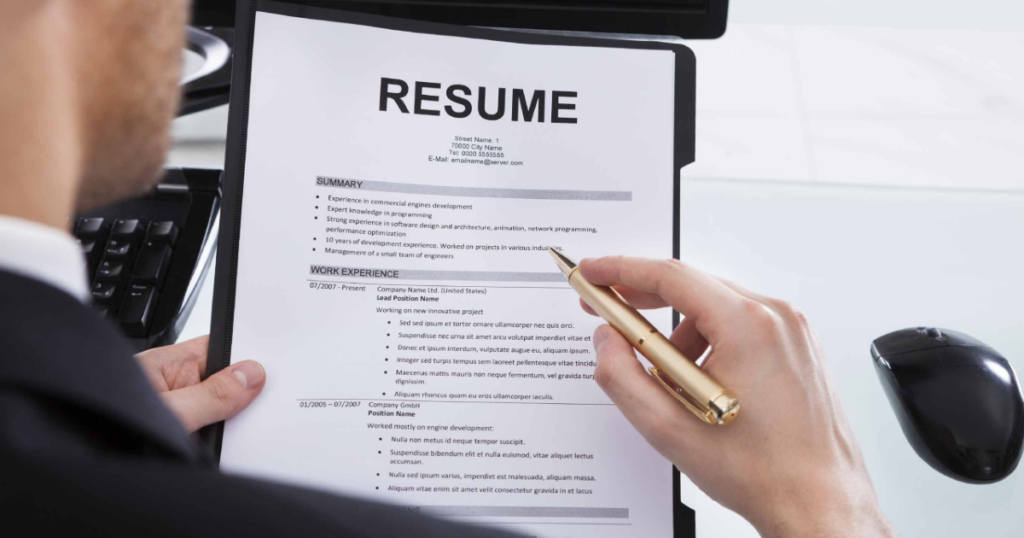
A resume is one of the most important pieces of paper you’ll ever write. It can be a determining factor in whether or not you get an interview, and it really needs to look good! In this article, we’ll provide tips on how to make your resume stand out from other applicants, and give examples of three common resume types: Traditional, chronological, and functional.
When deciding which resume format you should use, it’s important to consider what your most marketable skills are. Different resumes are better for different types of careers, so it’s best to choose the resume format that fits you, and aligns with the type of work you want to pursue.
When choosing a format, keep in mind which one will increase your chances at an interview. Since there isn’t really a wrong choice when picking between chronological, functional, or traditional formats, pick something that makes sense for your career trajectory.
For example: If you’ve worked at multiple jobs but still haven’t figured out exactly where you fit in the working world, then use a functional resume; if you feel like putting all those random experiences on paper together without bringing extra attention to specific employers, then use a chronological resume; and if you believe that your most marketable skills should be at the top of the page, then use a traditional resume.
The following tips should be taken into consideration when creating any type of resume:
When writing your resume, try using the following types of resumes depending on your work experience:
A functional resume is a type of resume that emphasises the applicant’s abilities and skills. It’s often used by people looking to make a career change, or those who have gaps in their employment. A recent graduate without extensive professional experience can also benefit from this type of resume. If you’ve gained important skills and experiences in areas other than professional employment, such as school or mentorship, you’ll also have an advantage with this format. By using this, employers can focus on a candidate’s skills, such as any technical or soft skills needed for the position.
A chronological resume is a format that prioritises relevant professional experience and achievements. If you have a lot of years of experience in one professional path and have worked for many businesses or clients in the same sector, a chronological resume is your best bet. It’s also critical that you have few or no gaps in your employment. This format is broken up into different sections. It shows what jobs you have before, and what you did when you were in them. It also tells how long you were on the job and what your responsibilities were. The chronological approach highlights key accomplishments throughout your career, making this sort of resume easy to follow, while also highlighting important abilities.
As the name suggests, it combines both chronological and functional resume types, allowing you to emphasise your skills and work experiences at one go. Due to the fact that more space could be used up with this type, you’ll need to eliminate or reduce other sections such as interests, summary, and objectives.

The goal of formatting your resume is to create a one-page document that can be quickly scanned, is easy to understand instantly at a glance, and highlights your most relevant information.
In addition to using the correct resume format (make sure to see which works best for you), there are many other formatting tips & tricks you should keep in mind:
Formatting mistakes, extreme tenses, long paragraphs, lack of bullet points or numbers – these are sure-fire ways to lose your reader’s interest fast, so make sure not to do them before sending it off.
Also, remember that every resume you send out is a reflection on yourself as a professional worker; take your time with this document because how it looks and reads is a big part of how your potential employer will perceive you.
This helps them see what skills and qualifications are most relevant to the position they’re hiring for – getting rid of any fluff or irrelevant information makes sure their time isn’t wasted.
If you’re looking to land a new job, it’s important that your resume reflects the type of work history an employer would want. For example, if you have had numerous short-term jobs in different fields but no long term employment, list one past experience first before listing each individual experience – this will allow employers to better see where these experiences fit into your career path from an outside perspective.
It’s also vital that formatting mistakes and other errors don’t go unnoticed by potential employers, as they can quickly lose interest in reading through resumes with typos or grammatical errors. If you’re unsure which format style is best for your background, take some time to consider what skills are most relevant to the position being offered at their company before deciding on how best to structure your resume.

Because leadership skills may have different meanings to various people, they are difficult to define. The skills that allow you to effectively talk with others and lead them toward a common objective are referred to as leadership. These skills constitute your personal brand of authority, such as charisma or confidence – characteristics that set you apart in any crowd. This article will explain what leadership skills are, how they can help you achieve your professional goals, and offer some advice on developing them.
Leadership skills are useful because they can help you achieve your career goals. Leadership is the ability to influence others and get them to work together towards a common goal. These leadership skills are important for any industry or job role, which is why it’s so critical that people take time out of their busy schedules to hone these very valuable skills.
While you’re in the early stages of your company, displaying leadership abilities can assist you in gaining clients, investors, and creditors. For example, when meeting clients for the first time, it’s your ability to lead and influence that will help you make a lasting impression on them. When you scale up your business, leadership abilities become even more important because they can be used to manage personnel. Whether you want to become the CEO of your company or manage a team of employees, leadership skills will come in handy in both scenarios.
Many company owners and managers seek leadership abilities in prospective employees. This is because good leaders possess the skills to get anything done, no matter what obstacles are in their way. Understanding the benefits of leadership skills can help you to become a better leader and successfully guide your subordinate towards success.
Leadership is a complex skill that incorporates many different talents. Some examples of skills that make a strong leader include:
A good leader knows that a project can’t be done overnight, and is able to patiently guide their employees through the process. To guide an employee through the project, good leaders must be able to understand that mistakes will happen along the way. They also need to know how to help that employee fix their mistake without it affecting the entire process. This isn’t an easy skill to learn; however, if you’re naturally patient and can put up with setbacks (and even acknowledge them), then you’re more likely to succeed and become a better leader.
No one wants to work for someone who constantly complains about everything or shows signs of negativity. A positive attitude helps you appear more approachable as well as contribute towards your team’s morale.

A good leader knows how to motivate their employees, which keeps them engaged and interested in the work they’re doing.
No one wants a company that’s stuck in the past; creativity is important for modernising your business or project.
As an employee or employer, you will be confronted with many conflicts. A good leader knows how to resolve these conflicts in a productive and timely manner.
A good leader knows how to empathise with their employees and understand the challenges they face.
A good leader is an active listener, which helps them better understand their employees and resolve issues efficiently.
A good leader is someone that employees can trust, and know that they’d be able to get the help and support of, in order to work correctly or succeed.
A good leader will do whatever it takes to see a project through from start to finish, which helps them gain the respect of their team members.
Making swift choices with authority.
A good leader knows how to persuade employees into following their vision and mission.
Attending to the needs of other individuals, like empathy for their feelings
Communicating well, either verbally or in writing. Being able to work well with others is an important leadership skill that can help you succeed in your career.
Having the ability to think creatively about businesses or projects will allow for innovative ideas .
Leaders should be able to prioritise their time, especially when it comes to communication.
A good leader knows how to teach and lead by example.
Being ready for unexpected projects or tasks that need to be done immediately .
Putting other people’s needs before your own, prioritising their ideas over yours.
Leaders should have a strong sense of achievement in order to feel successful.

By demonstrating leadership abilities in your company or career, you can pave the way to success. Leadership skills help you be a better leader and guide your employees towards accomplishing goals, which will help elevate your business. In any company, leadership is important for gaining respect from co-workers as well as clients.
To sharpen these essential skills , it’s helpful to take on new projects that push you outside of your comfort zone. It can also be beneficial to take on small tasks and projects around the office, as they allow you to show off these abilities in a more practical way.
For example, small task like organising meetings or events allow you to demonstrate leadership qualities like teamwork and reliability, which are important for moving up the career ladder. This will help develop leadership skills naturally over time, allowing employees or employers with this ability to become invaluable assets to any company or industry that needs them.
Depending on the industry you choose, certain types of leadership skills will be more beneficial to your career. For example, an art director may benefit from creativity and visionary thinking while a public relations representative would need active listening or persuasion abilities.
Career paths that can use these specific skill sets include marketing/advertising, business, public relations, event planning, real estate and human resource management.
While these essential traits are a good start for becoming a successful leader, there are also a number of other ways that can be helpful in elevating your career as well. A few of these include:

The first way an individual can grow their leadership skills is by taking on projects and tasks around the office that help develop those abilities over time. If there are no task options available, employees should take it upon themselves to volunteer for these kinds of roles. This will demonstrate a willingness to learn and be a team player, which can help develop leadership skills.
Next, find resources like books or podcasts about leadership and learn as much about them as possible. Many books on the subject exist, such as ‘On Becoming a Leader’ by J Warren Bennis. It is also beneficial to use online resources, such as e-books or articles that summarise the main points of leadership. These will help you understand it in a more practical way.
One can also participate in leadership training programs or seminars as well. You can find both in-person and online courses that allow you to grow your leadership skills.
Leadership skills are essential in any career, but they can be particularly important for those who want to become better leaders. Understanding the different types of leadership skills and how they work will help you take on new tasks or projects that push you outside of your comfort zone. It is also beneficial to use online resources like e-books about leadership as well as participate in seminars and training programs available both in-person and online.
Leadership skills should never stop developing, so it’s a good idea not only to read up on these topics but also stay abreast with current events related to management/leadership through podcasts or books. With a little time invested into understanding yourself more fully, taking charge of your own development journey and staying open minded, you’ll find that your leadership skills will grow exponentially over time.

When it comes to the hiring process, every detail counts. It’s important to make a good impression on your potential employer from the moment they see you and this includes putting together a cover letter that will get them excited about meeting with you.
When writing a good cover letter, there are certain things that you want to look out for:
In order to get your cover letter noticed, you have to make sure that it’s very clear what position you’re applying for and why. You should not bury this information in a lengthy introduction but instead include it as soon as possible so that they do not overlook it. This first paragraph should also tell them exactly how you found out about their company, or perhaps mention something which caught your eye, such as a recent article written by someone within the organisation. In general, try to keep things interesting and be specific.
Try to keep your cover letter somewhere between one and three paragraphs. This will help you avoid rambling on about things that aren’t necessary or relevant, while at the same time keeping them interested enough to continue reading. It’s also important not to get too detailed in describing what you did for each job as this can be found within your resume which should stand alone once submitted. You may wish to include a brief overview of the position, but focus more on how you would excel in this role than why they need someone like yourself – unless an employer specifies otherwise!
This is the part where you will want to go into a bit more detail regarding the experience that you’ve had under any previous employers. You should not simply list off your experiences but instead, think about how each job has specifically prepared you for the position in which you’re applying. This could include transfers within a company, a customer service role that led to management, working with a team, learning how to resolve conflicts etc. Try to connect what you’ve done previously to where you’re trying to go in the future.
When you’re writing a cover letter, it’s important to focus on the skills that match up with what they are looking for. If they ask for four years of experience within finance and accounting, then be sure to highlight these particular areas. You would also want to emphasise how you’ve developed certain soft skills such as communication or teamwork which will allow them to see that you can handle stressful situations or work well in a team environment. A hiring manager wants an employee who has both technical abilities and soft skills, but most importantly, someone who’s able to fit into their organisation seamlessly – so make sure not to forget to mention this when submitting your application!
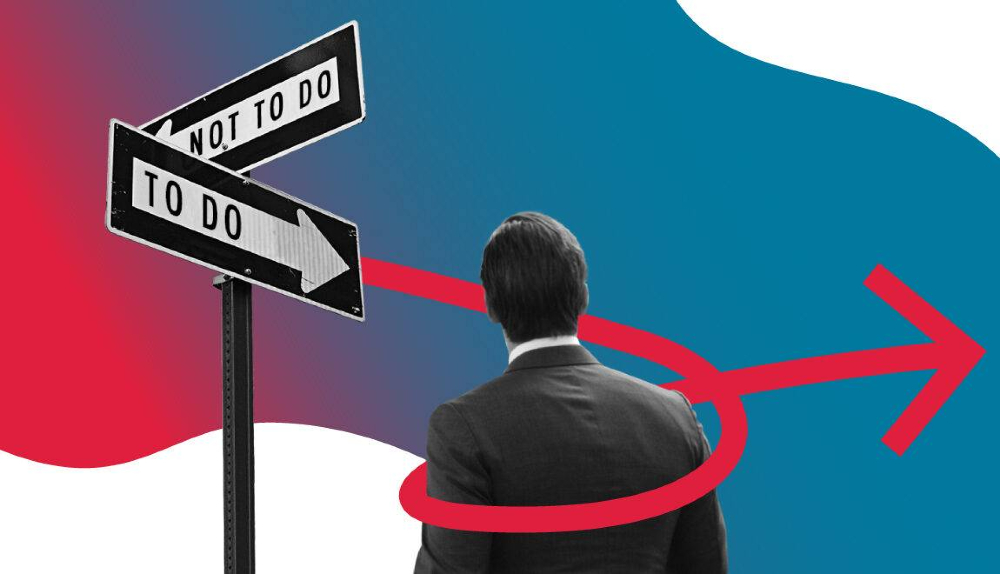
Be careful not to include any spelling mistakes (yes, even one mistake can be overlooked). You should also refrain from using any fancy fonts or colours, as this will only distract them and may not look so good once they print it out. Remember to proofread your letter several times before submitting the final version.
The first thing that you will want to do is get their attention with a greeting. You may wish to use either “Dear Hiring Manager” or simply the name of the person to who you will be sending this letter if they have shared it within their job advertisement. If not, then try using something like “To Whom It May Concern”.
Begin by stating your name, why you’re interested in their company and how you learned about the potential opportunity. This will help them get an idea of what kind of exposure that you’ve had throughout the industry – which may or may not be relevant depending on who is reading this document. Try including something such as “I am very excited about learning more about [insert role] with [insert company]. Your organisation has been at the forefront in recent news due to [insert reason here]”
You should then move on to tell them about yourself and why you would be excited for this opportunity. The first paragraph of your cover letter is not the time to go into too much detail so keep it short. This idea can be achieved by including a hook or interesting fact which will immediately capture their attention – something that they can relate to, an unusual accomplishment, or perhaps some courses you’ve attended.
Make sure that each sentence ties back into what makes you qualified for this role at their company. Focus more on explaining how these experiences have shaped who you are today rather than reciting every single task that was involved with your particular job within your cover letter. You do want employers to know what type of work ethic and skillsets that you possess but make sure that you’re not coming off as arrogant or conceited – nobody likes to read this!
Once you got the attention of your hiring manager, now is the time to discuss your previous employment history. Include any relevant prior work experience that may be related to what they are currently looking for. It’s important to describe how these roles have helped you develop certain skillsets whether it was dealing with difficult people or learning how to manage a team.

Once you’ve familiarised them with your background and experience, then it’s time to dive into why you’d be such an invaluable addition to their team. Do remember to highlight certain soft skills you’ve developed and honed over the years, like communication and teamwork, which will demonstrate that you’re someone who’s able to problem-solve effectively within a group of people! A hiring manager wants an employee who has both the hard and soft skills, but most importantly, they’ll look for a person who’s able to fit into their organisation seamlessly.
Be careful when describing yourself. Don’t brag too much but instead focus on highlighting specific skills and accomplishments. You would also want to keep your cover letter short and to the point so that they can get an idea of what you’re capable of within a limited amount of time.
Finally, make sure that you thank them for their time and consideration. Let them know that you would like to get the opportunity of interviewing with your company soon. You can also include a sentence such as “I look forward to hearing from you at [insert desired contact information]”
Ending it on a positive note is always best- this way they will be more likely to reach out if interested in moving forward with an interview since there is no pressure. They may not respond immediately so do not let this discourage you if it takes some time before receiving any feedback or communication after submitting your application. Wait patiently but still follow up once every week or two just in case someone has lost this cover letter. Thanking them again will remind them about who you are, and what you have to offer.
You can also include a sentence such as “I look forward to hearing from you at [insert desired contact information]”
Overall, the key to writing a good cover letter is understanding what makes your resume unique and tailoring it accordingly. Hiring managers don’t want to read through dozens of generic letters – they’re looking for someone who can add value immediately. You need to show that you have relevant experience or knowledge that will help them with their current needs while also detailing how this position aligns with your career goals.
Your cover letter should be no more than one page long so make sure not to include anything extraneous in order to avoid coming off as unfocused or scattered. There are many ways for you to stand out from the crowd but these four tips will allow you to start thinking about where you might fit at a company like theirs. Now all that’s left is filling out an application and sending over your resume.

Every business with an e-commerce website needs a web developer. This is why it comes as no surprise that web developers are in high demand. That being said, it’s not always a sure thing to be hired for a position just because you’re a skilled talent, after all you’re competing in a highly competitive career space.
A well-crafted resume or CV could easily help you secure a first interview with an industry-leading company. We’ve broken down the necessary sections, information and formats you should include in your web developer resume.
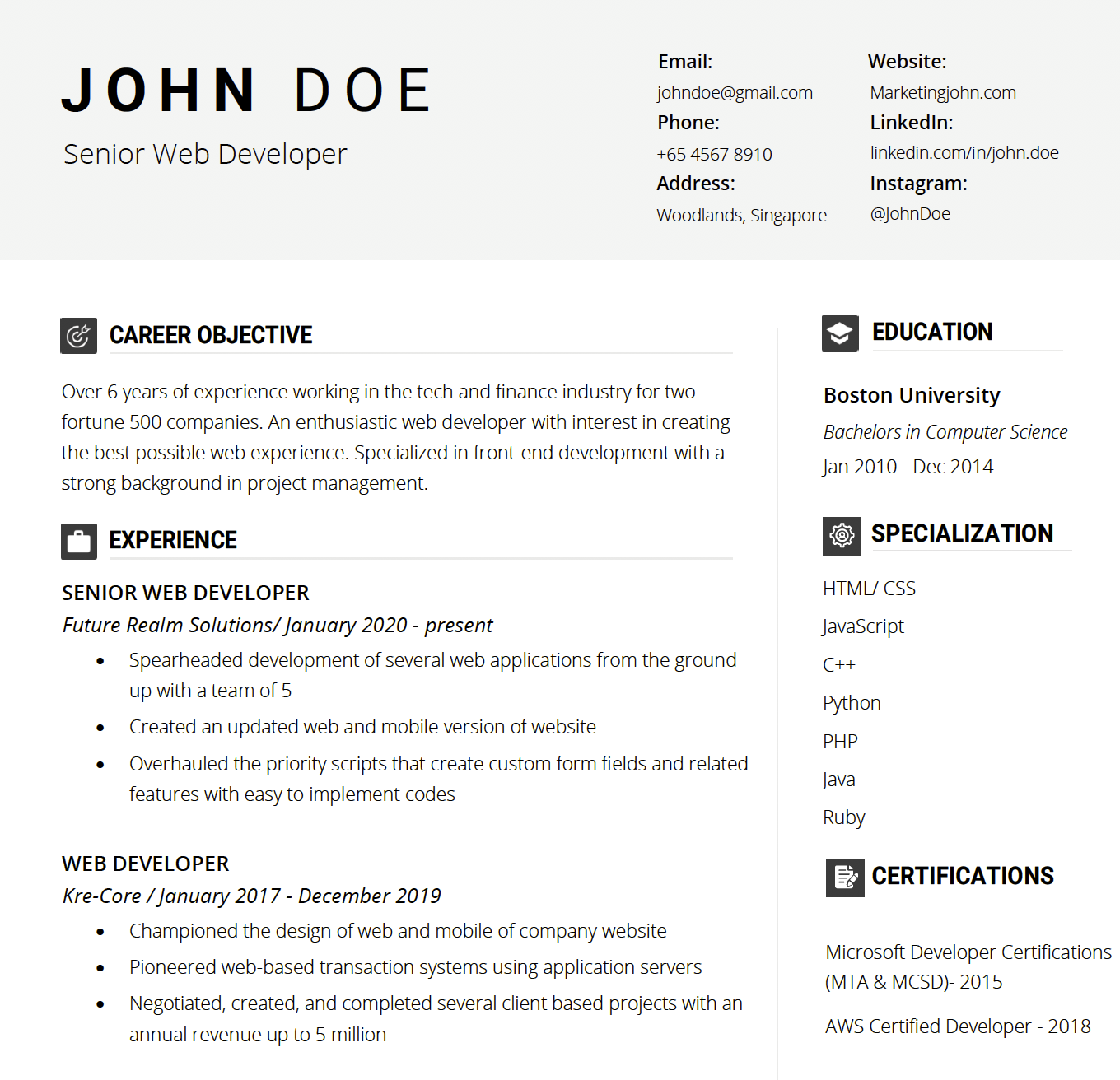
Keep all of the information on one page for a well-received resume. If your career spans further than a decade, you can get away with a two-page resume. Keep in mind that resumes should be concise and targeted. This is the flow of a resume you should follow:
As for formatting, these are the basics you need to know:
An overview of your professional background, qualifications and drive behind growing your career in this specific industry. Provide a glimpse into why you love what you do, or why you want to grow and develop skills further.
Example : Over 6 years of experience working in the tech and finance industry for two fortune 500 companies. An enthusiastic web developer with interest in creating the best possible web experience. Specialised in front-end development with a strong background in project management.
There are two things to always remember when writing your work experience section of your resume, bullet points, specific experience and wording.
#1 Bullet Points
#2 Specific Experience
1) The Job Description: Write client-side code to create easy-to-use and interactive web-based applications which include websites for both desktop and mobile browsers.
2) Your Experience: Restructured the code of several clients desktop and mobile browsers into easy-to-use and interactive web-based applications, resulting in a 90% decrease in interface issues.
Pro tip: Display your experience in a reverse-chronological order. It is one of the most common and go to ways to list your work experience. It’s easier for hiring managers to see the most relevant and recent work you’ve done.
Even without any work experiences you can still craft a great resume as someone starting their career journey, after all everyone has to start from somewhere. Here’s what you can include instead of full-time work experiences.
Action words are adjectives, used to describe while creating an impact and pull. It’s a great way to get the attention of the hiring manager, and make your achievements stand out. Words like these are great action words to consider when writing your resume:
A resume is short and sweet, so here’s what to mention in your resume and what to skip over.
In a separate piece of paper you’ll want to include the following to boost your chances at being selected for an interview. If you have a website with the following showcased, feel free to include your site under the contact information section of your resume.
If you’ve been meaning to up your value as a web developer, there are a handful of certificates you should look into regardless if you’re starting out or a veteran looking to sharpen your skills. Many are offered solely online with great time flexibility to work with your schedule and learning pace.
Here are some certificates worth considering:
Awards are a great reminder of the achievements you’ve accomplished for your company or with your industry.
An excellent companion to any resume, a cover letter provides you with the opportunity to go a little more into depth with why you’re the ideal candidate for the position. A cover letter also shows that you have a desire to work for the company you’re applying to, instead of sending out generic resumes to any company with an open role. The structure of your cover letter matters as much as the content itself.
You’ll want to make sure that the font size and spacing is as easy to read as it is pleasing to the eye. Also use action words when detailing your accomplishments and experiences that highlight your transferable skills to the position you’re hoping to get hired for.

You’re well versed in creating user friendly interfaces for even the most complex technical products out there, but writing a resume has you confused and overwhelmed. Rest assured, GRIT’s guide to writing a UI/UX designer’s resume is comprehensive with what you need to know about making your resume standout from the crowd.
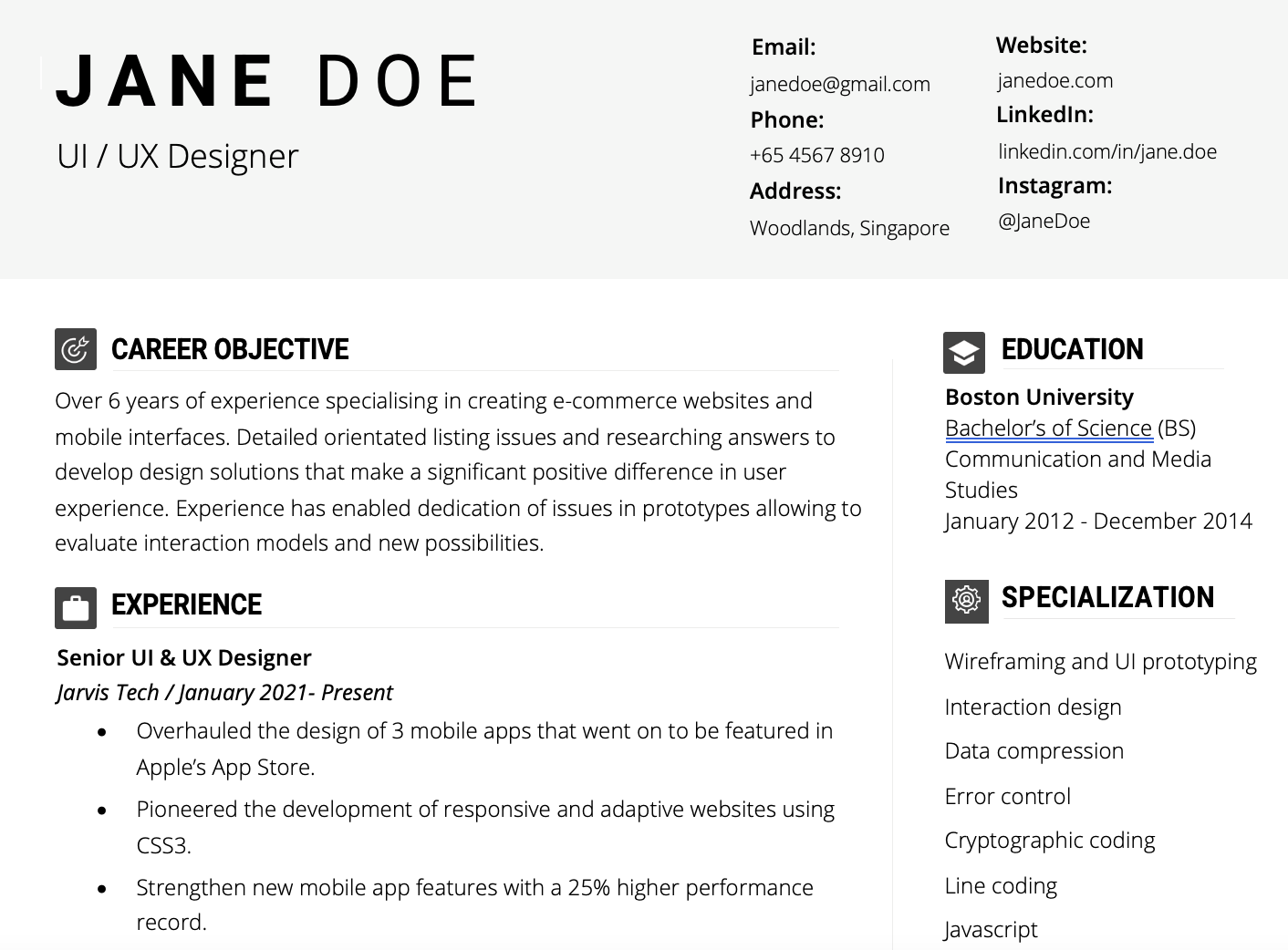
Keep all of the information on one page for a well-received resume. If your career spans further than a decade, you can get away with a two-page resume. Keep in mind that resumes should be concise and targeted. This is the flow of a resume you should follow:
As for formatting, these are the basics you need to know:
When writing your summary include a brief introduction into your professional background, qualifications, and motivation for advancing your career in this field. Give an example of why you enjoy what you do or why you wish to improve and expand your talents.
Example: Over 6 years of experience specialising in creating e-commerce websites and mobile interfaces. Detailed orientated listing issues and researching answers to develop design solutions that make a significant positive difference in user experience. Experience has enabled dedication of issues in prototypes allowing to evaluate interaction models and new possibilities.
When drafting your work experience portion of your resume, keep two things in mind: bullet points and specific experience.
#1 Bullet Points
#2 Specific Experience
1) The Job Description: Lead / participate in user and market research to produce interface analysis and constructive improvement practices.
2) Your Experience: Spearheaded several user and market research sessions to produce interface analysis and constructive improvement practices that contributed to a 30% increase for a better user experience.
Even without any work experiences you can still craft a great resume as someone starting their career journey, after all everyone has to start from somewhere. Here’s what you can include instead of full-time work experiences.
Action words in resumes are adjectives that are used to describe achievements and experiences. It’s a terrific method to get the attention of the hiring manager and highlight your accomplishments. Words like these are great action words to consider when writing your resume:
Since a resume is short and to the point, here’s what to include and what to leave out.
In a separate piece of paper you’ll want to include the following to boost your chances at being selected for an interview. If you have a website with the following showcased, feel free to include your site under the contact information section of your resume.
If you’ve been meaning to up your value as a web developer, there are a handful of certificates you should look into regardless if you’re starting out or a veteran looking to sharpen your skills. Many are offered solely online with great time flexibility to work with your schedule and learning pace.
Here are some certificates worth considering:
Awards are a great reminder of the achievements you’ve accomplished for your company or with your industry.
A cover letter is a terrific complement to any resume because it allows you to go into greater detail about why you’re the best fit for the job. Instead of sending out generic resumes to each potential employer with an open position, a cover letter demonstrates your want to work for the company you’re applying to. The structure of your cover letter matters as much as the content itself.
Make sure the font size and spacing are easily readable. When describing your successes and experiences, utilise action words to emphasise your relevant talents to the position you’re wanting to be recruited for.
Need a few more details?
Check out our in depth guides on writing a resume, CV and cover letter. All guides are suitable for any profession with tips for careers across the board.

As a software engineer, you’re constantly building the future with every role and project you take on. Yet, writing a resume still leaves you feeling overwhelmed. This guide to writing a software engineer resume is a breakdown of what you can expect to include in your resume to help bring the hiring manager’s attention your way.

Keep all of the information on one page for a well-received resume. If your career spans further than a decade, you can get away with a two-page resume. Keep in mind that resumes should be concise and targeted.
This is the flow of a resume you should follow:
As for formatting, these are the basics you need to know:
An overview of your professional background, qualifications and drive behind growing your career in this specific industry. Provide a glimpse into why you love what you do, or why you want to grow and develop skills further.
Example: 6 years of experience in mainframe developing and maintaining in the Technology industry. Spearheaded projects throughout all phases of the software development process with a focus on programming (C++ and Javascript).
When writing your work experience portion of your resume, there are two things to keep in mind: bullet points and specific experience.
#1 Bullet Points
#2 Specific Experience
1) The Job Description: Analyse requirements, design and develop functionalities based on the product requirements.
2) Your Experience: Implemented design and develop functionalities according to product requirements and analysis.
Even without any work experiences you can still craft a great resume as someone starting their career journey, after all everyone has to start from somewhere. Here’s what you can include instead of full-time work experiences.
Hiring managers are viewing dozens if not hundreds of resumes a day, if you want to stand out and grab their attention you’ll need to use action words. These are simply adjectives that are used to describe your achievements and experiences. Words like these are great action words to consider when writing your resume:
Since a resume is meant to be short and to the point, these three tips will help you avoid any possible mistakes.
In a separate piece of paper you’ll want to include the following to boost your chances at being selected for an interview. If you have a website with the following showcased, feel free to include your site under the contact information section of your resume.
If you’ve been meaning to up your value as a web developer, there are a handful of certificates you should look into regardless if you’re starting out or a veteran looking to sharpen your skills. Many are offered solely online with great time flexibility to work with your schedule and learning pace. Here are some certificates worth considering:
Awards are a great reminder of the achievements you’ve accomplished for your company or with your industry.
A cover letter is a terrific complement to any resume because it allows you to go into greater detail about why you’re the best fit for the job. Instead of sending out generic resumes to each potential employer with an open position, a cover letter demonstrates your want to work for the company you’re applying to. The structure of your cover letter matters as much as the content itself.
Ensure that the font size and spacing are both readable and easy on the eye. Use action words to emphasise your relevant skills to the position you wish to be hired for while explaining your achievements and experiences.
Need a few more details? Check out our in depth guides on writing a resume, CV and cover letter. All guides are suitable for any profession with tips for careers across the board.

You’re a master at sales, and can easily close on many large deals, but do you find yourself inadvertently freezing up when it comes to selling yourself on your resume? Our guide to writing a sales director resume is perfect for those of you that need that extra help. Understand the fundamentals of what your resume needs to consist of, and what you could do to stand out from the crowd in terms of skills.
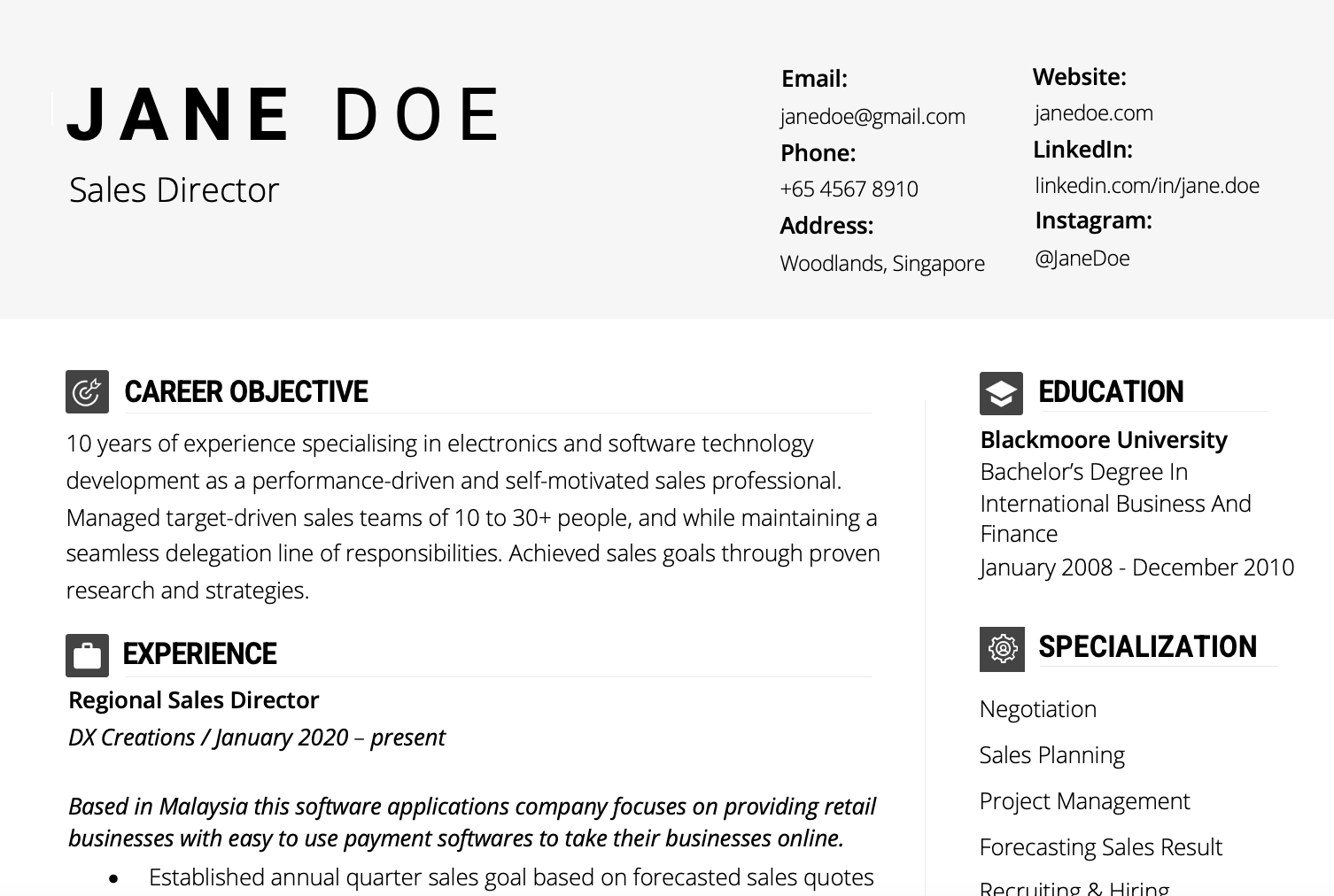
Do keep all of the information on one page for a well-received resume. If your career spans further than a decade, you can get away with a two-page resume. Keep in mind that resumes should be concise and targeted. This is the flow of a resume you should follow:
As for formatting, these are the basics you need to know:
A summary should consist of your professional background, qualifications and reasons for wanting to grow your career in this specific industry. Share why you love what you do and how you plan to develop skills further with this role.
Example: 10 years of experience specialising in electronics and software technology development as a performance-driven and self-motivated sales professional. Managed target-driven sales teams of 10 to 30+ people, and while maintaining a seamless delegation line of responsibilities. Achieved sales goals through proven research and strategies.
When writing your work experience portion of your resume, there are two things to keep in mind: bullet points and specific experience.
#1 Bullet Points
#2 Specific Experience
1) The Job Description: Coach, and mentor senior Account Executives, with a hands-on, team-oriented approach.
2) Your Experience: Empowered a team of 10 Account Executives with a hands-on, team-oriented approach that contributed to increasing sales by 35% from the initial sales target for 2020.
Even without any work experiences you can still craft a great resume as someone starting their career journey, after all everyone has to start from somewhere. Here’s what you can include instead of full-time work experiences.
Hiring managers are viewing dozens if not hundreds of resumes a day, if you want to stand out and grab their attention you’ll need to use action words. These are simply adjectives that are used to describe your achievements and experiences. Words like these are great action words to consider when writing your resume:
Since a resume is meant to be short and to the point, these 3 tips will help you avoid any possible mistakes.
In a separate piece of paper you’ll want to include the following to boost your chances at being selected for an interview. If you have a website with the following showcased, feel free to include your site under the contact information section of your resume.
If you’ve been meaning to up your value as a web developer, there are a handful of certificates you should look into regardless if you’re starting out or a veteran looking to sharpen your skills. Many are offered solely online with great time flexibility to work with your schedule and learning pace.
Awards are a great reminder of the achievements you’ve accomplished for your company or with your industry.
A cover letter is a terrific complement to any resume because it allows you to go into greater detail about why you’re the best fit for the job. Instead of sending out generic resumes to each potential employer with an open position, a cover letter demonstrates your want to work for the company you’re applying to. The structure of your cover letter matters as much as the content itself.
Ensure that the font size and spacing are both readable and easy on the eye. Use action words to emphasise your relevant skills to the position you wish to be hired for while explaining your achievements and experiences.
Need a few more details?
Check out our in depth guides on writing a resume, CV and cover letter. All guides are suitable for any profession, with tips for careers across the board.

Strategising and creating the right roadmap for a product or product line is what product directors do best. But what about writing attention grabbing resumes? GRIT’s got you covered with this product director resume guide. Simple to follow tips and tricks to help you stand out and land that first round interview with your dream company.
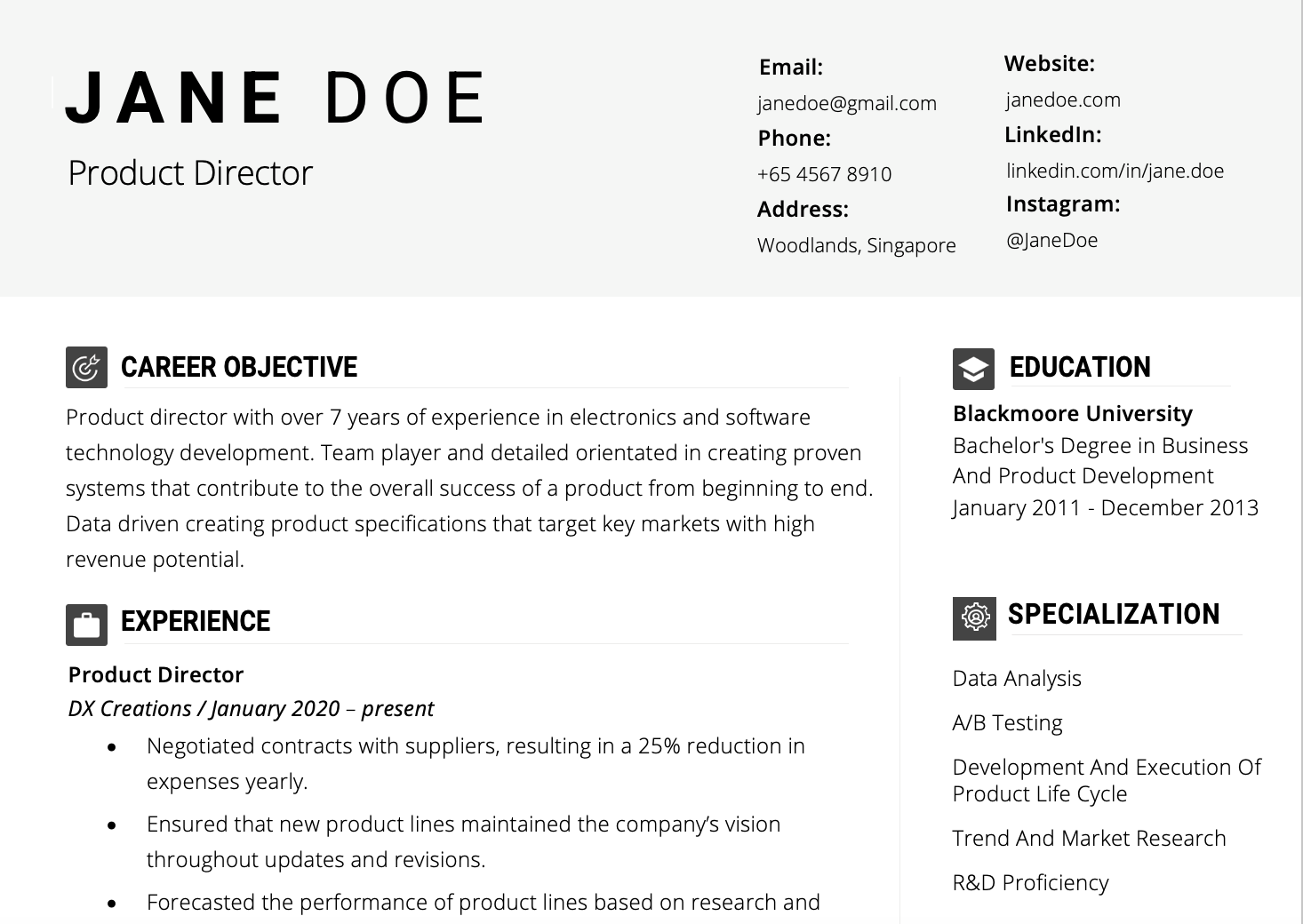
If you want your resume to be well-received by the hiring managers, keep all of the information on one page. You can get away with a two-page resume if your career extends more than a decade. Remember that resumes should be focused and concise. This is the flow of a resume you should follow:
As for formatting, these are the basics you need to know:
An overview of your professional background, qualifications and drive behind growing your career in this specific industry. Provide a glimpse into why you love what you do, or why you want to grow and develop skills further.
Example: Product director with over 7 years of experience in electronics and software technology development. Team player and detailed orientated in creating proven systems that contribute to the overall success of a product from beginning to end. Data driven creating product specifications that target key markets with high revenue potential.
When drafting your work experience portion of your resume, keep two things in mind: bullet points and specific experience.
#1 Bullet Points
#2 Specific Experience
1) The Job Description: Technical and have built platforms and foundational products at scale to serve diverse customers, and have owned product life cycle from conception to launch to market fit.
2) Your Experience: Spearheaded a team of 20 with the construction of platforms and foundational products at scale to serve target customers from conception to launch, including market fit.
Even without any work experiences you can still craft a great resume as someone starting their career journey, after all everyone has to start from somewhere. Here’s what you can include instead of full-time work experiences.
Action words in resumes are adjectives that are used to describe achievements and experiences. It’s a terrific method to get the attention of the hiring manager and highlight your accomplishments. Words like these are great action words to consider when writing your resume:
Since a resume is short and to the point, here’s what to include and what to leave out.
In a separate piece of paper you’ll want to include the following to boost your chances at being selected for an interview. If you have a website with the following showcased, feel free to include your site under the contact information section of your resume.
If you’ve been meaning to up your value as a web developer, there are a handful of certificates you should look into regardless if you’re starting out or a veteran looking to sharpen your skills. Many are offered solely online with great time flexibility to work with your schedule and learning pace.
Awards are a great reminder of the achievements you’ve accomplished for your company or with your industry.
A cover letter is a terrific complement to any resume because it allows you to go into greater detail about why you’re the best fit for the job. Instead of sending out generic resumes to each potential employer with an open position, a cover letter demonstrates your want to work for the company you’re applying to. The structure of your cover letter matters as much as the content itself.
Make sure the font size and spacing are as easily readable as they are appealing to the eye. When describing your successes and experiences, utilise action words to emphasise your relevant talents to the position you’re wanting to be recruited for.
Need a few more details? Check out our in depth guides on writing a resume, CV and cover letter. All guides are suitable for any profession with tips for careers across the board.

Network engineers are essential to the structure of any organisation. Developing, setting up, and maintaining the internal computer networks of an organisation requires the very best individuals. This is why it’s no surprise that there’s an influx of openings for network engineer roles. To even be considered for a role as a network engineer, you’ll need a killer resume. GRIT’s guide will surely set you on the right course with a captivating resume.

Keep all of the information on one page for a well-received resume. If your career spans further than a decade, you can get away with a two-page resume. Keep in mind that resumes should be concise and targeted. This is the flow of a resume you should follow:
As for formatting, these are the basics you need to know:
When writing your summary include a brief introduction into your professional background, qualifications, and motivation for advancing your career in this field. Give an example of why you enjoy what you do or why you wish to improve and expand your talents.
Example: Network Engineer with over 7 years of experience in network design, programming, network and systems administration. Excellent skills in delivering technical support, managing network operations, and maintaining enterprise-wide area networks across multi-platform and high uptime Data Center environments.
When drafting your work experience portion of your resume, keep two things in mind: bullet points and specific experience.
#1 Bullet Points
#2 Specific Experience
1) The Job Description: Test Architectural design solutions to produce detailed engineering specifications with recommended design and vendor technologies.
2) Your Experience: Established detailed engineering specifications with recommended design and vendor technologies by testing various design solutions.
Even without any work experiences you can still craft a great resume as someone starting their career journey, after all everyone has to start from somewhere. Here’s what you can include instead of full-time work experiences.
Action words in resumes are adjectives that are used to describe achievements and experiences. It’s a terrific method to get the attention of the hiring manager and highlight your accomplishments. Words like these are great action words to consider when writing your resume:
Since a resume is short and to the point, here’s what to include and what to leave out.
In a separate piece of paper you’ll want to include the following to boost your chances at being selected for an interview. If you have a website with the following showcased, feel free to include your site under the contact information section of your resume.
If you’ve been meaning to up your value as a network engineer, there are a handful of certificates you should look into regardless if you’re starting out or a veteran looking to sharpen your skills. Many are offered solely online with great time flexibility to work with your schedule and learning pace.
Here are some certificates worth considering:
Awards are a great reminder of the achievements you’ve accomplished for your company or with your industry.
A cover letter is a terrific complement to any resume because it allows you to go into greater detail about why you’re the best fit for the job. Instead of sending out generic resumes to each potential employer with an open position, a cover letter demonstrates your want to work for the company you’re applying to.
The structure of your cover letter matters as much as the content itself.
Make sure the font size and spacing are easily readable. When describing your successes and experiences, utilise action words to emphasise your relevant talents to the position you’re wanting to be recruited for.
Need a few more details? Check out our in depth guides on writing a resume, CV and cover letter. All guides are suitable for any profession with tips for careers across the board.

There’s no industry that’s growing in popularity and at an incredible pace the same way IT is anywhere in the world. This has resulted in an influx of IT professional roles opening up. If you’ve been having some trouble writing your resume to land one of these openings, we’ve got you covered. GRIT has broken down what you should and should not include in an IT manager’s resume!
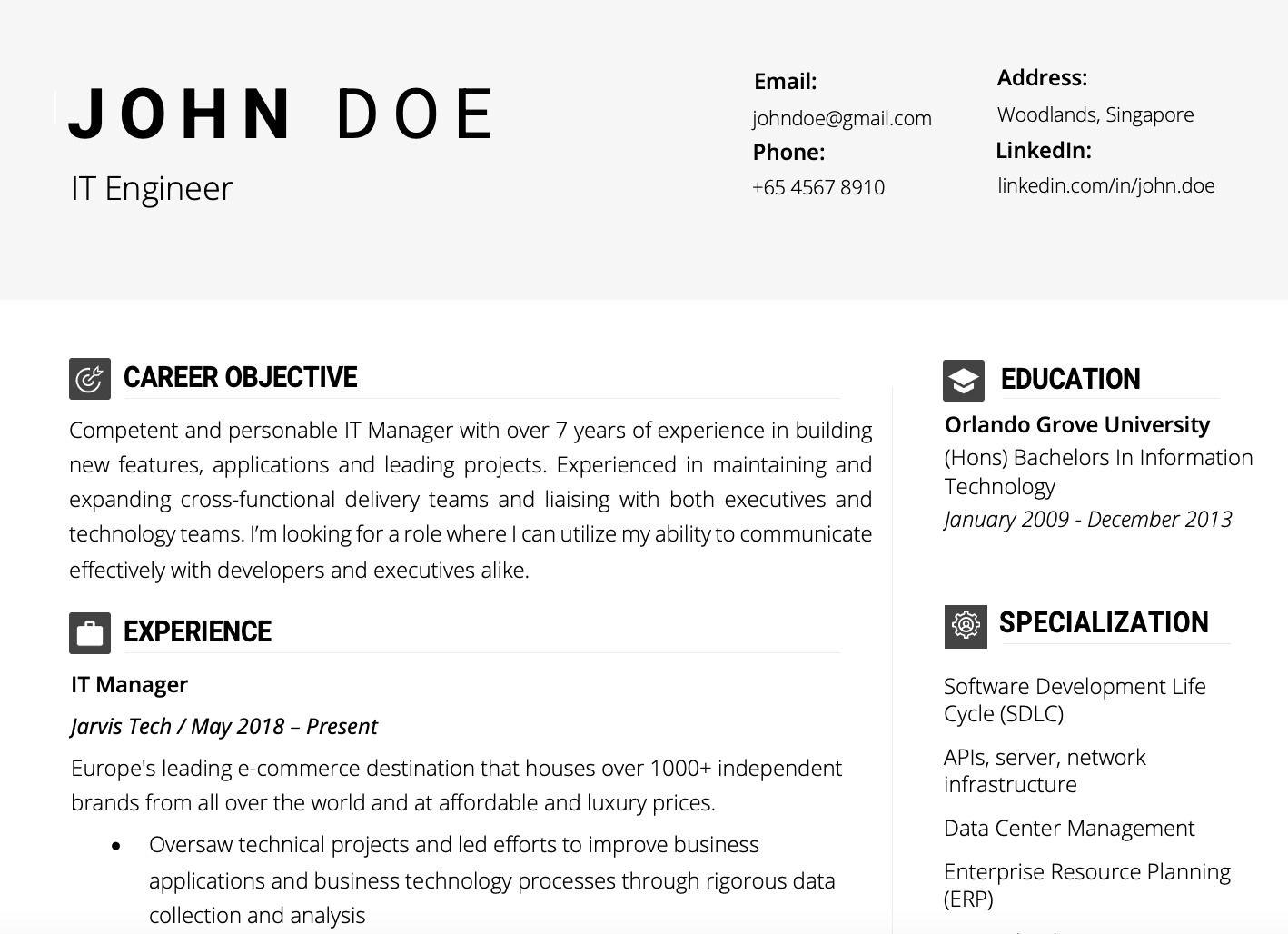
Keep all of the information on one page for a well-received resume. If your career spans further than a decade, you can get away with a two-page resume. Keep in mind that resumes should be concise and targeted. This is the flow of a resume you should follow:
As for formatting, these are the basics you need to know:
When writing your summary, include a brief introduction into your professional background, qualifications, and motivation for advancing your career in this field. Give an example of why you enjoy what you do, or why you wish to improve and expand your talents.
Example: Competent and personable IT Manager with over 7 years of experience in building new features, applications and leading projects. Experienced in maintaining and expanding cross-functional delivery teams and liaising with both executives and technology teams. I’m looking for a role where I can utilise my ability to communicate effectively with developers and executives alike.
When drafting your work experience portion of your resume, keep two things in mind: bullet points and specific experience.
#1 Bullet Points
#2 Specific Experience
1) The Job Description: Ensure that the user requirements, criteria and scope are clearly defined for new projects. Projects are to be managed using Agile Working Model (AWM).
2) Your Experience: Updated user requirements, criteria and scope for every new project using Agile Working Model (AWM) to simplify and manage each project.
Even without any work experiences, you can still craft a great resume as someone starting their career journey, after all everyone has to start from somewhere. Here’s what you can include instead of full-time work experiences.
Action words in resumes are adjectives that are used to describe achievements and experiences. It’s a terrific method to get the attention of the hiring manager and highlight your accomplishments. Words like these are great action words to consider when writing your resume:
Since a resume is short and to the point, here’s what to include and what to leave out.
In a separate piece of paper you’ll want to include the following to boost your chances at being selected for an interview. If you have a website with the following showcased, feel free to include your site under the contact information section of your resume.
If you’ve been meaning to up your value as an IT manager, there are a handful of certificates you should look into regardless if you’re starting out or a veteran looking to sharpen your skills. Many are offered solely online with great time flexibility to work with your schedule and learning pace.
Here are some certificates worth considering:
Awards are a great reminder of the achievements you’ve accomplished for your company or with your industry.
A cover letter is a terrific complement to any resume because it allows you to go into greater detail about why you’re the best fit for the job. Instead of sending out generic resumes to each potential employer with an open position, a cover letter demonstrates your want to work for the company you’re applying to. The structure of your cover letter matters as much as the content itself.
Make sure the font size and spacing are easily readable. When describing your successes and experiences, utilise action words to emphasise your relevant talents to the position you’re wanting to be recruited for.
Need a few more details? Check out our in depth guides on writing a resume, CV and cover letter. All guides are suitable for any profession with tips for careers across the board.